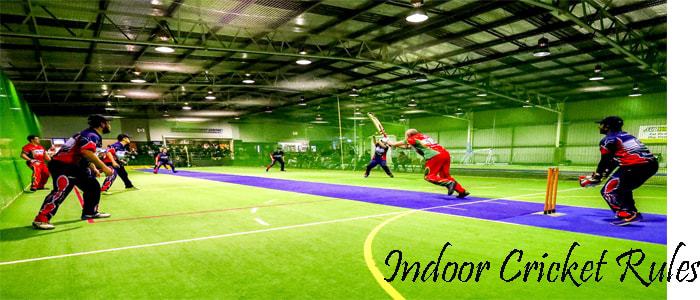
Indoor Cricket Rules
Indoor cricket is very similar to cricket which is played at the outdoor stadium. But playing area in indoor cricket is less as compared to cricket. Two batsmen, a bowler, and a team of fielders required to play indoor cricket. The batsman must have to score runs at the end of match highest score team wins the match. Every international cricketer scan tries to play indoor cricket for practice if it not possible to play outside. In this article, we will share indoor cricket rules.
Rules & Regulation of Indoor Cricket
Players
Indoor cricket is played between two teams. Each one team required 8 players to play indoor cricket. Every player must have to bowl 2 overs in an innings. In batting each player can bat in a partnership for 4 overs. In indoor cricket, an innings lasts for 16 overs.
Scoring Area

The scoring area in indoor cricket is divided into two areas. Physical runs and bonus runs are two scoring area in indoor cricket. When batsmen complete a run from one crease to other is called as Physical runs. When a ball hit to the net is called as Bonus runs as per indoor cricket rules. In indoor cricket, we can score runs in four zones. Zone A is a front net which is behind the keeper if a ball goes in this area it will count 0 runs. Zone B is a side net which is between the striker’s ends and halfway down the pitch if a ball goes in zone B they count 1 run. Zone C is a side net which is between half and at the bowler’s end, it gives 2 runs. Zone D is a back net which is behind the bowler it gives 4 0r 6 runs depends on the ball hit to the back net.
For e.g.: if a ball bounce and hit to back net it will be 4 runs. If a ball directly hit the back net it will be 6 runs. If batsmen have to score a bonus runs at least one physical run required to score. For e.g.: a batsman played the ball and hit it to full on the back net and he runs one physical run, the total run scored is 7 runs.
League Rules
Each team must have 8 players in their team to play indoor cricket. Twelve six ball overs consist each innings and it should be completed in 30 minutes. Five runs will give to batting team for each one minute which you run over specified time. Team winning tosses choose either to bat or bowl first.
Batting Rules
Every batsman will bat in pairs for 3 overs. If batsmen can’t change ends 5 run penalty restricted to batting team. A shot hitting ball wall that bounces across the ground at least once it counts as “four” runs. Shot hitting the back wall directly with no bounce on the ground count as “six runs”. LBW dismissal is not being a valid wicket in indoor cricket.
Bowling Rules
A bowler can bowl a maximum of two overs but it cannot be consecutive. All ball which passes the leg side of the batsmen is “wide”. Ball bounce directly to batsmen over waist height declared as a “No ball”. No balls give two runs to batting team. Two runs will be given to batting team for wide’s and no balls with no extra ball delivery.
Rule Of 3 Dot Balls
3 dot balls rules were invented in indoor cricket. 3 Dot balls rules mean that “the scoreboard has to change in at least every third ball of the match. For e.g.: if batsmen played two consecutive Dot balls then in next ball he has to score runs but if he played 3rd consecutive Dot ball he will be declared as “out” and also 5 runs will be reduced by team score. If it happens automatically scorecard will be changed on the third ball.
Related Article –
Leave a Reply